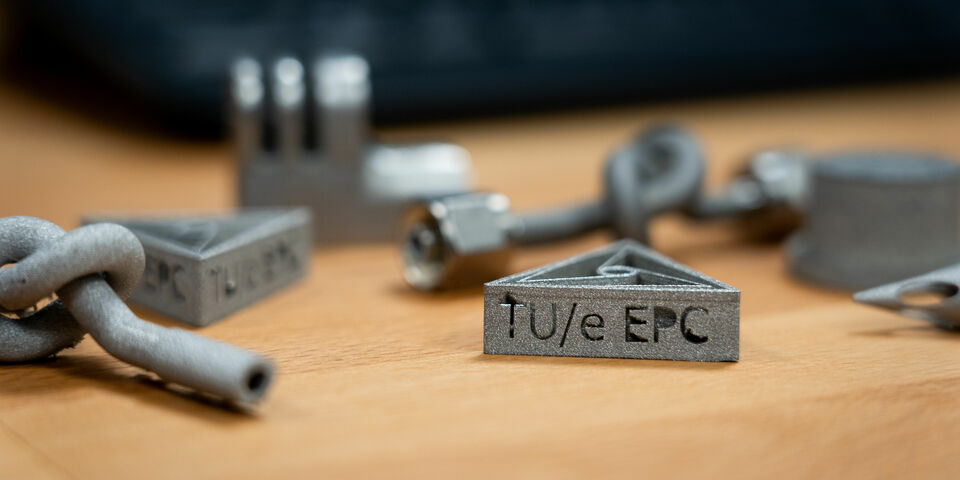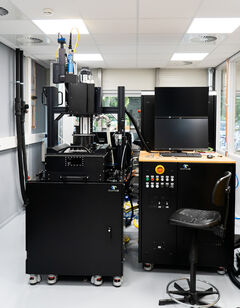New 3D printer at TU/e should help enable nuclear fusion
Melting pure grains of metal into unique shapes using a minuscule laser point: the new 3D printer at the Equipment and Prototype Center (EPC) makes it possible. Energy research institute DIFFER, together with TU/e researchers, will use the printer to develop heat shields for nuclear fusion reactors. In the meantime, the EPC may use the printer for individual projects.
The machine is able to print with aluminum, stainless steel and titanium, among other materials, but the most important thing for DIFFER is that it can also fuse tungsten. This material can withstand extreme conditions, which is necessary when creating a heat shield for a nuclear fusion reactor, because inside, temperatures can reach up to 150 million degrees Celsius.
However, the very properties that make tungsten so well-suited for such applications also make it an incredibly difficult material to print with, says associate professor Hans van Dommelen from the Department of Mechanical Engineering, who is also involved in the research project with DIFFER. “Tungsten has a very high melting point, but also high thermal conductivity, which means it quickly loses heat. And it’s very brittle at low temperatures, which leads to cracks.”
Research should help to better understand the printing process. “We’re going to look at how the material is formed and why the cracks appear. This will help us learn how to print better and more accurately.” The new printer’s specifications allow the researchers to go much further in terms of conditions compared to regular metal printers, Van Dommelen explains.
Liquid metals
The reason why the tungsten for the heat shields needs to be printed is because it must have an open structure on the inside, allowing liquid metals like lithium or tin to seep through. This liquid is supposed to reduce the erosion of the tungsten. “Heat-resistant reactor walls are currently still made of solid tungsten blocks,” says Van Dommelen. “That’s sufficient for fusion reactors like ITER in France, which are only switched on for experiments from time to time. But for the next generation of reactors, such a wall will no longer suffice. The material needs to be able to withstand, for years, conditions equivalent to ten times the stress a space shuttle experiences upon re-entry of the atmosphere.”
Since liquid metal has no crystal structure like tungsten, the plasma and neutrons in the reactor will simply be unable to break it down. By creating a sponge-like structure on the surface of the tungsten, the liquid metal can be held in place.
LiMeS
“It’s only a concept at this point, but in theory, it should work,” says Van Dommelen. “It’s not a functional solution yet. To achieve that goal, the LiMeS (Liquid-Metal Shield) lab was established in collaboration with DIFFER.” Thanks to the award of a 2.5-million-euro NWO Large grant, it was possible to set up the lab, including the printer – though it is housed in the EPC. A plasma setup will be built later at DIFFER to test the shields. The ‘testing stage’ of the research mainly involves TU/e’s Applied Physics department.
Recently, the research project received additional funding through NWO’s Open Technology Program. Philips is involved as well. “Philips in Best is already printing a lot of tungsten. They have quite a lot of expertise,” says Van Dommelen. “The company is also researching ways to improve the printing process, but the machine we have now is much more advanced in terms of specifications than theirs.” That is why it is beneficial for the parties to work together on this research, he believes.
The knowledge and expertise available at the EPC can be helpful to the project, Van Dommelen thinks. There, several experiments have already been carried out with the machine: on a table next to the 3D printer is a knotted vacuum tube, a beer opener and a test block for the heat shield project (see main photo). These are all tests to assess the printing process and the strength of the material and to identify any internal stresses, says Erwin Dekkers, who coordinated the installation of the printer at the EPC.
What makes this 3D printer special, he says, is the way the metal is fused together. “At a speed of five meters per second, a laser writes a shape into a very thin layer of metal powder; so thin, in fact, that you would need about a thousand layers for a thirty-millimeter-tall piece. With each layer, the base plate lowers a bit. Once the printer is done, you brush away all the powder to reveal the finished piece. We then filter that powder for reuse, so there’s very little waste.” Because they work with pure metal, there are no by-products or contamination in the result, which enhances the quality, he adds.
Powder
The only downside is that the printer is very slow; it takes hours just to print a small block of metal. And operating the machine is not straightforward because it can be dangerous, Dekkers says. “That mainly has to do with the powder we use. Inhaling it or having it come into contact with your skin is harmful. Stainless steel powder is also potentially carcinogenic which is why we have to wear a lot of protective gear. The room is well sealed and has negative pressure to prevent any powder from escaping.”
For specific titanium and aluminum powders, flammability is also an issue; that powder can easily ignite or even explode. However, that will never happen inside the machine itself because it has an argon atmosphere and no oxygen. The fact that the instrument engineers are required to wear full-face masks in order to 3D print is not really a problem either, according to Dekkers. “I heard they’re quite comfortable.”
Make it ourselves
Dekkers is not sure when the real research work with the printer will begin. So far, the EPC has mainly used it to print fuel injectors and heat exchangers. But there are many possibilities, he emphasizes. “Burners, reactors, waveguides, coolers, heaters and unusual shapes that can’t be produced any other way: we can make it all. We can also make things for student teams. In the past, we reworked parts for University Racing Eindhoven that were printed by other companies; now we can make those kinds of parts ourselves.” So feel free to come to them with your projects, he means to say.



Discussion